Step into the bustling cityscape, where amidst the concrete jungles and towering skyscrapers, the Rock Dove (Columba livia) reigns as an enduring symbol of urban resilience.
Commonly known as the pigeon, this ubiquitous bird has adapted seamlessly to the urban environment, captivating observers with its grace and adaptability.
Join us on a journey to uncover the fascinating world of the Rock Dove as we delve into its natural history, behaviors, and cultural significance.
From ancient city squares to modern metropolises, Rock Doves have long been companions to humans, sharing our urban landscape and witnessing the ebb and flow of city life.
With their distinctive cooing calls and iridescent plumage, these avian denizens remind us of the interconnectedness between nature and humanity.
They serve as familiar neighbors and enduring symbols of resilience in the ever-changing urban landscape. Let’s dive right in.
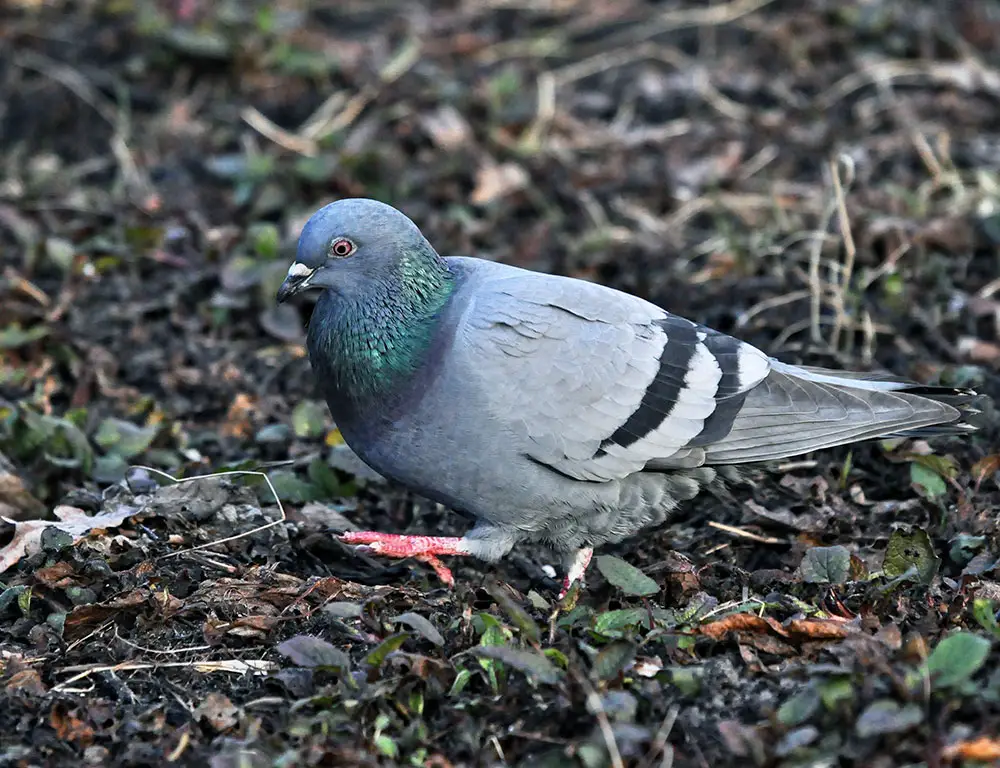
Key Physical Characteristics of the Rock Dove
Rock Doves, commonly known as pigeons, exhibit various physical traits that enable them to thrive in various environments. Let’s explore their key physical characteristics in detail:
Size and Shape
Rock Doves are medium-sized birds, typically measuring between 29 and 37 centimeters (11 to 15 inches) in length, with a wingspan of around 64 to 72 centimeters (25 to 28 inches).
They have a compact, streamlined body with a small head, short neck, and sturdy legs.
Plumage
Rock Doves display various plumage colors and patterns, depending on their geographical location and individual genetics.
Wild-type Rock Doves typically have a grayish-blue body with darker wing feathers, a white rump, and two black bars on each wing.
However, domesticated pigeons come in various colors, including white, brown, black, and shades of blue and gray.
Iridescent Feathers
Upon closer inspection, Rock Dove feathers often exhibit iridescence, especially in sunlight. This iridescence results from the microscopic structure of the feathers, which refracts light and produces shimmering colors ranging from green and purple to bronze and copper.
Head and Neck
Rock Doves have a small, rounded head with a distinctive feature called a cere—a fleshy, raised area at the base of the beak.
The cere is often a different color from the rest of the bird’s plumage and may change color during breeding season. They also have a short, slender neck, which they can extend and retract as needed.
Beak
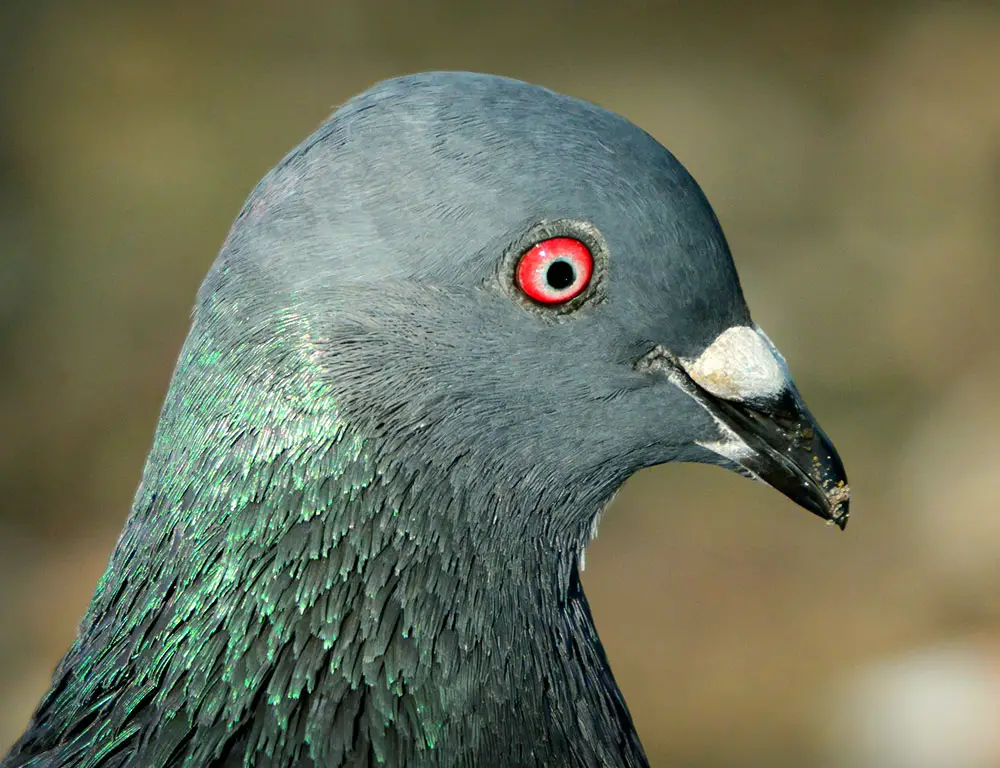
The beak of a Rock Dove is relatively short and stout, with a slightly curved tip. It is well-suited for pecking at food and grasping tiny seeds. The color of the beak varies among individuals, ranging from pale yellow or pinkish to dark gray or black.
Eyes
Rock Doves have round, dark eyes on either side of their head, providing panoramic vision and excellent depth perception. Their eyesight is highly developed, allowing them to detect predators and locate food sources from a distance.
Wings and Flight
Rock Doves have broad, pointed wings that enable them to maneuver and glide gracefully through the air.
They are strong fliers capable of covering long distances, often reaching speeds of up to 77 kilometers per hour (48 miles per hour). Their wings produce a distinctive whistling sound during flight.
Tail
The tail of a Rock Dove is relatively short and squared off at the tip, with 12 feathers arranged in a fan-like pattern. The tail is a rudder during flight, helping the bird maintain stability and control.
Legs and Feet
Rock Doves have strong, muscular legs adapted for walking, running, and perching. Their feet have four toes, three of which point forward and one backward, giving them a firm grip on various surfaces.
Voice
Rock Doves are known for their cooing calls, which vary in pitch and rhythm depending on the context. These vocalizations serve various purposes, including communication between mates, establishing territory, and warning of potential threats.
A Deeper Look into the Life History of the Rock Dove
Rock Doves, also known as pigeons, have a fascinating life history that spans various aspects of their biology and behavior. Let’s delve into these key aspects:
Taxonomy
| Taxonomy Level | Classification |
| Kingdom | Animalia |
| Phylum | Chordata |
| Class | Aves |
| Order | Columbiformes |
| Family | Columbidae |
| Genus | Columba |
| Species | Columba livia |
Food Habitat
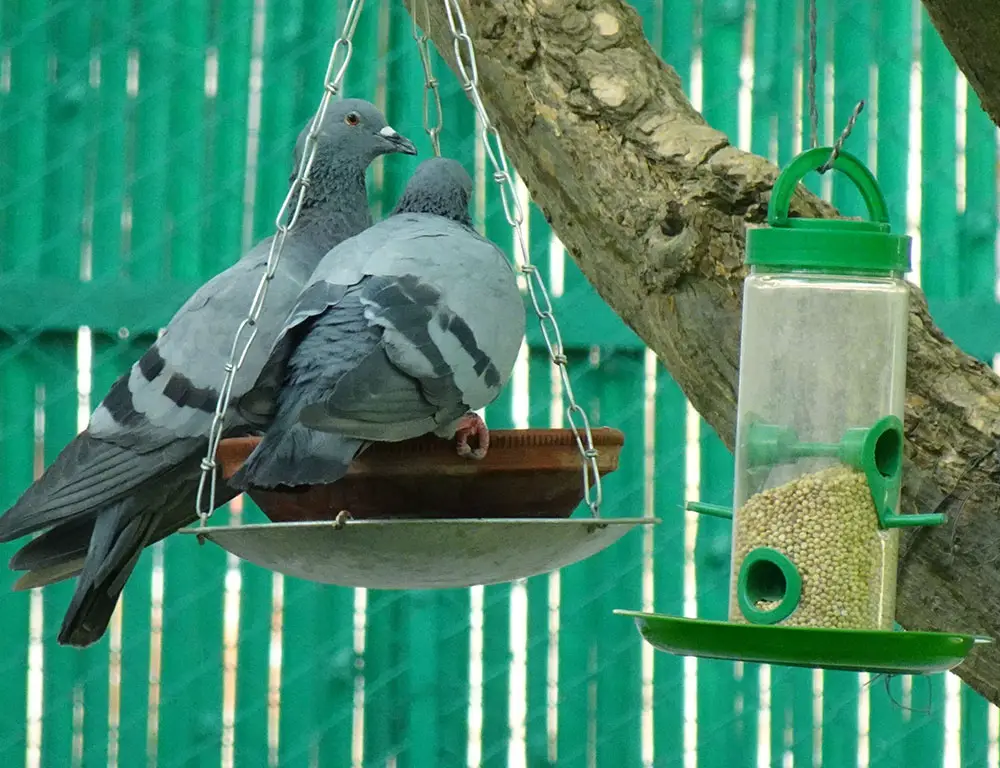
Rock Doves are highly adaptable and opportunistic feeders, consuming a diverse diet that includes grains, seeds, fruits, and human food scraps.
They are commonly found foraging on the ground in urban areas, parks, agricultural fields, and open grasslands, where they scavenge for food.
Nesting Habits
| Nest Type | Description |
| Platform Nest | Rock Doves typically construct simple nests made of twigs, grass, and other plant materials, forming a loose platform structure on ledges, building eaves, or other elevated surfaces, providing some protection from predators and the elements. |
| Clutch Size | A typical clutch consists of two white eggs, although clutch size may vary depending on factors such as food availability and environmental conditions. |
| Incubation Period | Both male and female Rock Doves share incubation duties, with each taking turns to sit on the eggs for approximately 17 to 19 days until they hatch. |
| Chick Development | Hatchlings are altricial, meaning they are born helpless and rely on their parents for warmth and food. They fledge in about 25 to 32 days and remain dependent on their parents for several weeks after leaving the nest. |
Breeding
Rock Doves are monogamous and may form long-term pair bonds, especially during the breeding season.
Courtship displays involve the male puffing up his chest, cooing, and bowing to attract a mate. Once a pair bond is formed, both parents contribute to nest building, incubation, and chick rearing.
Range Map

Rock Doves are widely distributed across all continents except Antarctica due to their close association with human habitation.
They are particularly abundant in urban and suburban areas, where they exploit food resources and nesting sites provided by human activities.
Social Behavior
Rock Doves are highly social birds that exhibit complex behaviors and interactions within their flocks. These flocks can consist of hundreds or thousands of individuals and may roost together in communal sites such as building ledges or trees.
Within flock dynamics, Rock Doves establishes a social hierarchy through displays of dominance and submission.
Conservation Status and Threats
While Rock Doves are widespread and abundant in urban areas worldwide, they face a range of threats that impact their populations. Destruction of natural habitats and urban development can limit available nesting sites and foraging areas for Rock Doves.
Urban environments expose Rock Doves to various forms of pollution, including air pollution, water contamination, and ingesting littered debris.
What Are the Common Diseases and Treatments of the Rock Dove?
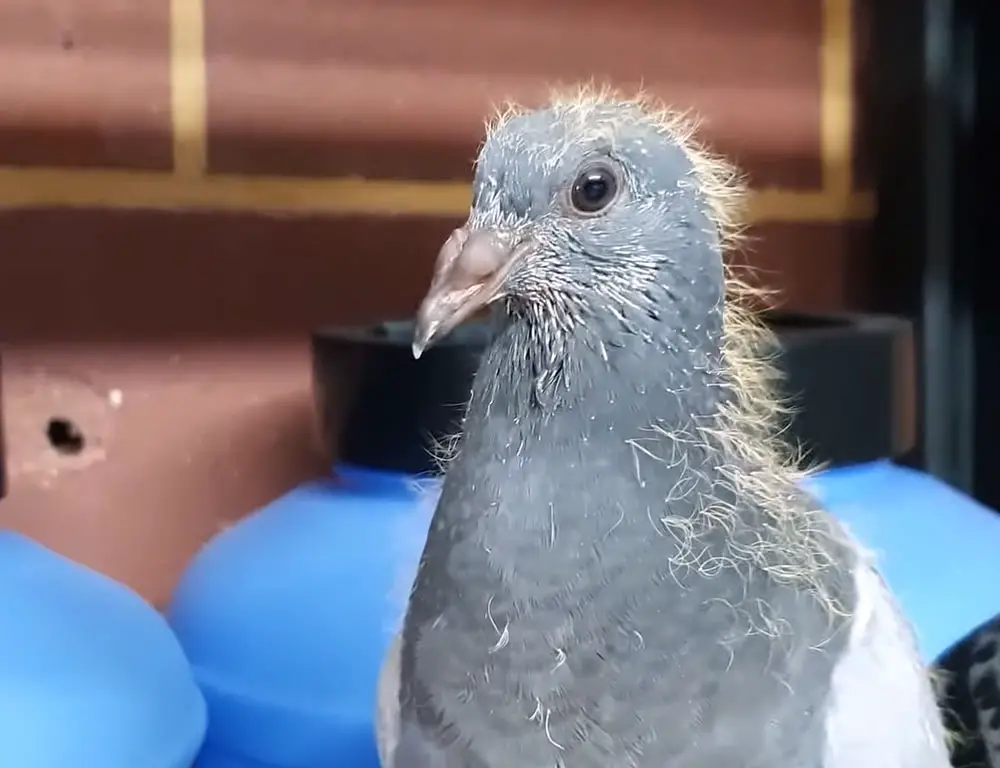
Rock Doves, like other bird species, are susceptible to various diseases. Some of the common diseases affecting Rock Doves include:
Avian Pox
Avian pox is caused by a virus transmitted by biting insects such as mosquitoes. It manifests as wart-like growths on the skin, mucous membranes, and internal organs.
Treatment involves supportive care, including proper nutrition and hydration, as no specific antiviral treatment is available. Preventive measures include controlling insect vectors and maintaining good hygiene in bird habitats.
Trichomoniasis
Trichomoniasis, caused by the protozoan parasite Trichomonas gallinae, affects birds’ upper digestive tract, leading to mouth and throat lesions. Infected birds may exhibit difficulty swallowing, regurgitation, and weight loss.
Treatment typically involves administering antiprotozoal medications such as metronidazole or ronidazole orally or via drinking water.
Coccidiosis
Coccidiosis is a parasitic disease caused by protozoan parasites of the genus Eimeria. It affects the intestinal tract of birds, leading to diarrhea, weight loss, and dehydration.
Treatment involves administering anticoccidial medications such as amprolium or sulfa drugs orally or via drinking water.
Salmonellosis
Salmonellosis is a bacterial infection caused by various strains of Salmonella bacteria. Infected birds may exhibit symptoms such as diarrhea, lethargy, and decreased appetite.
Treatment involves administering antibiotics such as enrofloxacin or amoxicillin under the guidance of a veterinarian. Preventive measures include maintaining clean feeding and watering areas and minimizing contact with wild bird populations.
Respiratory Infections
Respiratory infections can be caused by various bacteria, viruses, or fungi and may result in symptoms such as nasal discharge, coughing, and difficulty breathing.
Treatment depends on the specific pathogen involved, including antibiotics, antifungal medications, or supportive care to alleviate symptoms.
10 Fun Facts About the Rock Dove
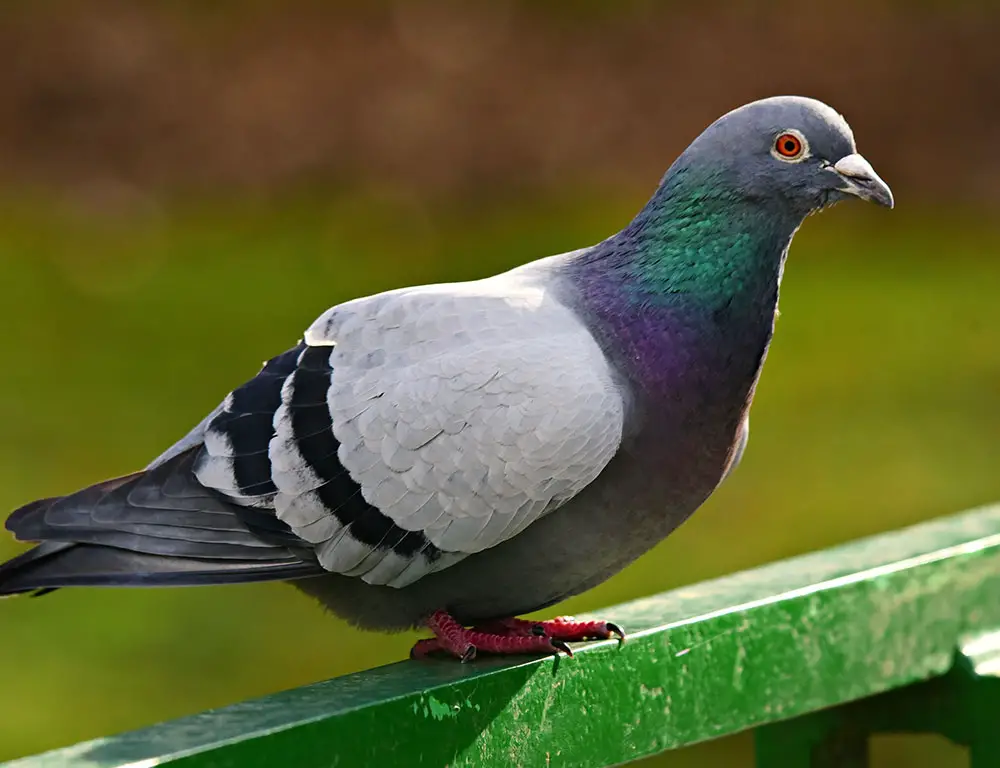
Here are 8 fun facts about the Rock Dove, also known as the common pigeon:
1. Urban Adaptability
Rock Doves are highly adaptable birds and thrive in urban environments, making them a familiar sight in cities worldwide. Their ability to exploit human-made structures for nesting and food sources has earned them the nickname “city pigeons.”
2. Historical Significance
Rock Doves have a long history of association with humans, dating back thousands of years. They were domesticated by ancient civilizations and used for various purposes, including messenger pigeons, food, and religious sacrifices.
3. Excellent Homing Instinct
Rock Doves possess an exceptional homing instinct, allowing them to find their way back to their nest site or roosting area from long distances. For centuries, this trait has been exploited in pigeon racing and homing competitions.
4. Variety of Colors
While wild Rock Doves typically have grayish-blue plumage with darker wing feathers, domesticated pigeons come in various colors and patterns. Selective breeding has produced pigeons with diverse appearances, including solid colors, pied patterns, and even feather crests.
5. Mating Rituals
Male Rock Doves perform elaborate courtship displays during the breeding season to attract females. These displays may involve puffing up their chests, strutting in circles, and bowing repeatedly while cooing to impress potential mates.
6. Crop Milk
Both male and female Rock Doves produce a nutritious secretion called crop milk to feed their young. Crop milk is regurgitated from the adult’s crop—a specialized pouch in the esophagus—and provides essential nutrients for the growing chicks.
7. Acrobatic Flyers
Rock Doves are skilled fliers and capable of agile maneuvers in the air. They often perform aerial displays, including looping flights, rapid wing beats, and synchronized group flights, especially during the breeding season.
8. Long Lifespan
Despite facing numerous challenges in urban environments, Rock Doves can live relatively long lives, with some individuals surviving for up to 15 years or more in the wild.
They can live even longer in captivity, where they are protected from predators and provided with ample food.
FAQs
Are Rock Doves and pigeons the same species?
Yes, Rock Doves (Columba livia) are commonly called pigeons. They are the same species, with “Rock Dove” as their scientific name and “pigeon” as their common name.
How long have Rock Doves lived in the wild?
Rock Doves have an average lifespan of 3 to 5 years in the wild, although some individuals may live longer in favorable conditions.
Do Rock Doves migrate?
While some populations of Rock Doves may exhibit seasonal movements, they are generally sedentary birds, especially in urban areas where food sources are abundant year-round.
What do Rock Doves eat?
Rock Doves are omnivorous and feed on various foods, including grains, seeds, fruits, insects, and human food scraps. They are often seen foraging on the ground in parks, plazas, and other urban areas.
Do Rock Doves carry diseases?
Like all birds, Rock Doves can carry various diseases and parasites, some of which may be transmissible to humans. However, the risk of disease transmission from Rock Doves to humans is generally low with proper hygiene practices and minimal contact with wild birds.
Conclusion
The Rock Dove is an emblem of urban resilience and adaptability, seamlessly integrating into the fabric of modern city life.
From its origins as a cliff-dwelling species to its widespread presence in urban centers worldwide, the Rock Dove embodies the remarkable ability of wildlife to thrive in human-altered environments.
As we reflect on its natural history and cultural significance, we are reminded of the complex relationship between humans and wildlife and the importance of coexistence in shared urban spaces.
Despite being often overlooked or even seen as pests, Rock Doves play a vital role in urban ecosystems, contributing to seed dispersal, scavenging, and providing a connection to the natural world for city dwellers.
Through conservation efforts and responsible urban planning, we can ensure the continued presence of Rock Doves in our cities while fostering a greater appreciation for the diversity of life that enriches our urban landscapes.